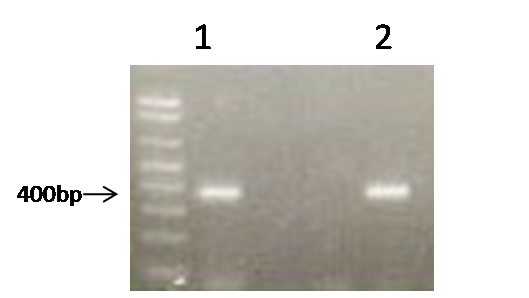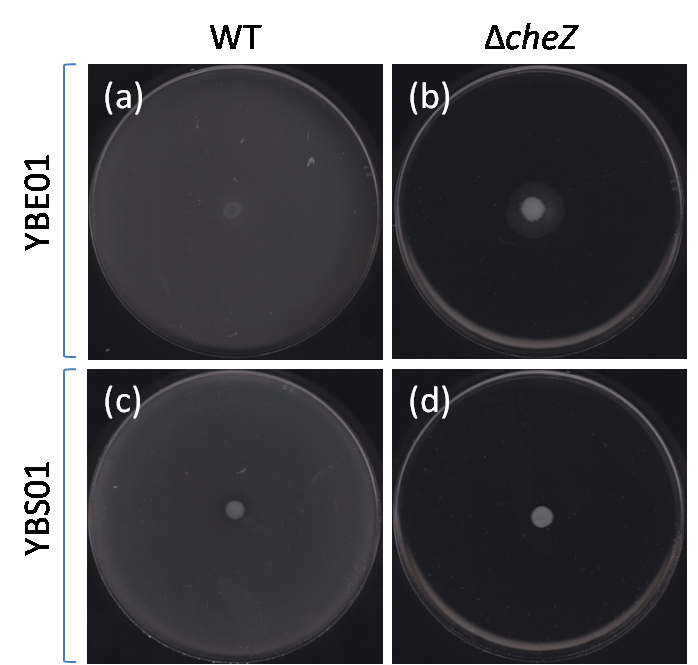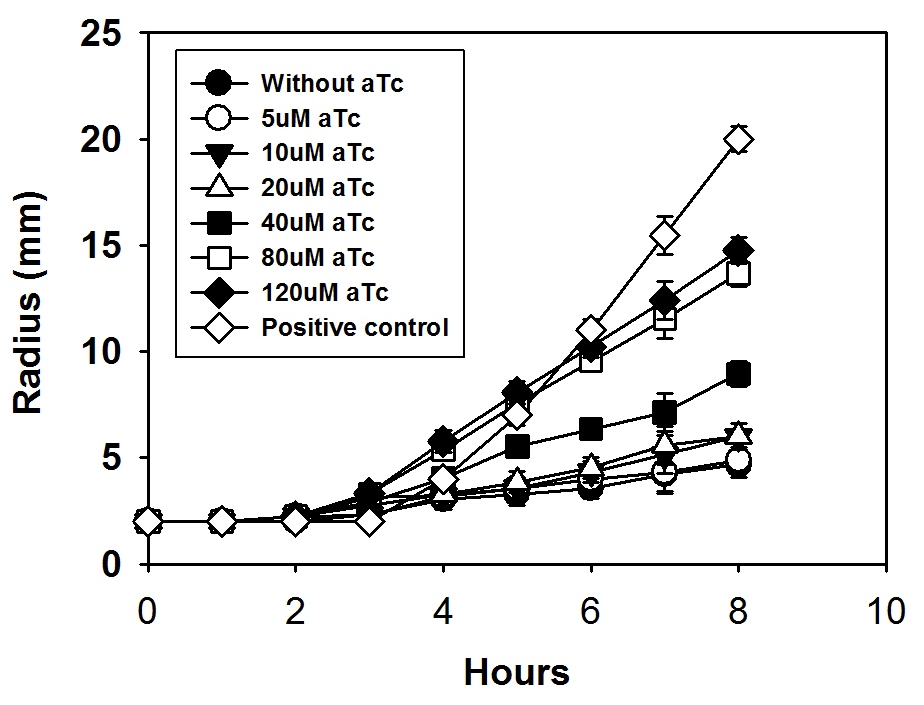Team:HKU-HKBU/Speed Control Results
From 2009.igem.org
(→Speed control) |
|||
| (43 intermediate revisions not shown) | |||
| Line 5: | Line 5: | ||
=Results= | =Results= | ||
| - | =='''''cheZ'' knockout | + | =='''''cheZ'' knockout in YBE01 and YBS01'''== |
| - | ''cheZ'' knockout is a | + | ''cheZ'' knockout is a crucial step for speed control. We believed that by controlling the expression level of ''cheZ'', we could manipulate the ratio of flagella rotating direction (clockwise & counterclockwise). Therefore, higher concentration of expressed CheZ could lead to faster swimming speed. This part played a key role as an "adapter" of bactomotor. |
| - | ===Colony PCR | + | ===Colony PCR=== |
| - | |||
| - | By using recombineering technology, cheZ could be precisely replaced by | + | [[Image:HKU-HKBU delta cheZ2.png|center|thumb|'''Figure.1''' Colony PCR for ''cheZ'' knockout in ''E.coli'' and ''S. typhimurium'' strains. 1, YBS01; 2, YBE01|300px]] |
| + | |||
| + | |||
| + | |||
| + | By using recombineering technology, ''cheZ'' could be precisely replaced by selective resistance marker with homologous arms (about 50-bp). To test the result, colonies were selected on the agar plate with chloramphenicol resistance followed by colony PCR test. In the PCR reaction, forward primers were designed in the upstream of ''cheZ'' locus in the chromosome and reverse primer was designed inside the chlromphenicol gene. The result of colony PCR test could examine whether the recombination procedure was successful or not. The expected DNA size of this test was about 400 bp. The DNA agrose gel picture indicated the ''cheZ'' gene was knocked out both in YBE01 and YBS01 strains. | ||
===Swimming Test=== | ===Swimming Test=== | ||
| - | + | Based on the theory of speed control, the ''cheZ'' knockout strain could not swim at all. Therefore 3 percent half solid agar was used for testing the swimming ability. After observing the spread of the bacteria constantly for 8 hours, the patterns of YBE01 and YBS01 strains were formed as follows and the ''cheZ'' knockout strains showed that the ineffectiveness of the swimming ability of the two bacteria strains, which was an indication of the successful knockout of ''cheZ'' gene in YBE01 and YBS01. | |
| + | |||
| + | |||
| + | |||
| + | [[Image:HKU-HKBU_speed_control_experiments_Fig3.png |center|thumb|'''Figure. 2''' Swimming assays of ''E.coli'' and ''S. typhimurium'' strains.''' a,''' YBE01; '''b,''' ''cheZ'' knock-out YBE01 (YBE02); '''c,''' YBS01; '''d,''' ''cheZ'' knock-out YBS01 (YBS02). | ||
| + | |500px]] | ||
==Regulation of ''cheZ'' expression== | ==Regulation of ''cheZ'' expression== | ||
| - | + | To control the expression level of ''cheZ'', a series of plasmids were constructed, such as plasmid plac/ara-his-cheZ-cm ( [http://partsregistry.org/wiki/index.php?title=Part:BBa_K283014 '''BBa_K283014'''] ), which could be induced by IPTG or arabinose. This plasmid ( [http://partsregistry.org/wiki/index.php?title=Part:BBa_K283014 BBa_K283014] ) was transformed to YBS02 and YBE02. Different concentrations 1, 2, 3.3 uM of IPTG were added into the cultivating solution LB to induce ''cheZ'' expression. | |
| - | + | ||
| - | ==== | + | ===Western Blot=== |
| - | + | ||
| - | + | The samples were collected from different cultivation time and various IPTG concentrations. Obvious concentration gradient was observed with the induce time of 24 hours with different IPTG concentrations, which indicated that the inducer IPTG could control the expression level of CheZ. | |
| - | |||
| - | === | + | |
| + | [[Image:HKU-HKBU speed control western4.png |center|thumb|'''Figure. 3''' Western blotting result of CheZ expression in YBE02 with different concentration of IPTG. 1, without IPTG; 2, with 1uM IPTG; 3, with 2uM IPTG; 4, with 3.3uM IPTG | ||
| + | |500px]] | ||
| + | |||
| + | |||
| + | Although [http://partsregistry.org/wiki/index.php?title=Part:BBa_K283014 '''BBa_K283014'''] could control the expression of CheZ, the leak expression could cause the failure of swimming control. Therefore, more powerful system [http://partsregistry.org/wiki/index.php?title=Part:BBa_K283002 '''BBa_K283002'''] must be constructed to prevent the leak. | ||
| + | |||
| + | ===Speed control === | ||
| + | The speed was detected by the swimming assay. The swimming with TetR repress [http://partsregistry.org/wiki/index.php?title=Part:BBa_K283002 '''BBa_K283002'''], the swimming radius was measured each hour continuously for 8 hours. The results indicated that without aTc inducer, the bacteria only tumbled; and when aTC was added into cultivation LB broth, the bacteria were started to swim. And the swimming speed of bacteria could be controlled 'Speed up' with increasing aTc concentration. This result indicated that the alternation of aTc concentrations could be an effective way to control speed. | ||
| + | |||
| - | [[Image: | + | [[Image:Speed control aTc2.JPG|center|thumb|'''Figure. 4''' Swimming speed assay by different concentration inducer aTc. |
| - | + | |500px]] | |
| + | |||
| + | =='''Conclusion'''== | ||
| - | + | We successfully knock-out ''cheZ'' gene in both YBE01 and YBS01 strains. Re-introduction of ''cheZ'' gene restored their swimming ability. Moreover, the swimming speed of these two strains was shown to be adjustable by different amounts of chemical inducers. | |
{{Team:HKU-HKBU/footer}} | {{Team:HKU-HKBU/footer}} | ||
Latest revision as of 02:54, 22 October 2009
Contents |
Results
cheZ knockout in YBE01 and YBS01
cheZ knockout is a crucial step for speed control. We believed that by controlling the expression level of cheZ, we could manipulate the ratio of flagella rotating direction (clockwise & counterclockwise). Therefore, higher concentration of expressed CheZ could lead to faster swimming speed. This part played a key role as an "adapter" of bactomotor.
Colony PCR
By using recombineering technology, cheZ could be precisely replaced by selective resistance marker with homologous arms (about 50-bp). To test the result, colonies were selected on the agar plate with chloramphenicol resistance followed by colony PCR test. In the PCR reaction, forward primers were designed in the upstream of cheZ locus in the chromosome and reverse primer was designed inside the chlromphenicol gene. The result of colony PCR test could examine whether the recombination procedure was successful or not. The expected DNA size of this test was about 400 bp. The DNA agrose gel picture indicated the cheZ gene was knocked out both in YBE01 and YBS01 strains.
Swimming Test
Based on the theory of speed control, the cheZ knockout strain could not swim at all. Therefore 3 percent half solid agar was used for testing the swimming ability. After observing the spread of the bacteria constantly for 8 hours, the patterns of YBE01 and YBS01 strains were formed as follows and the cheZ knockout strains showed that the ineffectiveness of the swimming ability of the two bacteria strains, which was an indication of the successful knockout of cheZ gene in YBE01 and YBS01.
Regulation of cheZ expression
To control the expression level of cheZ, a series of plasmids were constructed, such as plasmid plac/ara-his-cheZ-cm ( [http://partsregistry.org/wiki/index.php?title=Part:BBa_K283014 BBa_K283014] ), which could be induced by IPTG or arabinose. This plasmid ( [http://partsregistry.org/wiki/index.php?title=Part:BBa_K283014 BBa_K283014] ) was transformed to YBS02 and YBE02. Different concentrations 1, 2, 3.3 uM of IPTG were added into the cultivating solution LB to induce cheZ expression.
Western Blot
The samples were collected from different cultivation time and various IPTG concentrations. Obvious concentration gradient was observed with the induce time of 24 hours with different IPTG concentrations, which indicated that the inducer IPTG could control the expression level of CheZ.
Although [http://partsregistry.org/wiki/index.php?title=Part:BBa_K283014 BBa_K283014] could control the expression of CheZ, the leak expression could cause the failure of swimming control. Therefore, more powerful system [http://partsregistry.org/wiki/index.php?title=Part:BBa_K283002 BBa_K283002] must be constructed to prevent the leak.
Speed control
The speed was detected by the swimming assay. The swimming with TetR repress [http://partsregistry.org/wiki/index.php?title=Part:BBa_K283002 BBa_K283002], the swimming radius was measured each hour continuously for 8 hours. The results indicated that without aTc inducer, the bacteria only tumbled; and when aTC was added into cultivation LB broth, the bacteria were started to swim. And the swimming speed of bacteria could be controlled 'Speed up' with increasing aTc concentration. This result indicated that the alternation of aTc concentrations could be an effective way to control speed.
Conclusion
We successfully knock-out cheZ gene in both YBE01 and YBS01 strains. Re-introduction of cheZ gene restored their swimming ability. Moreover, the swimming speed of these two strains was shown to be adjustable by different amounts of chemical inducers.
 "
"




